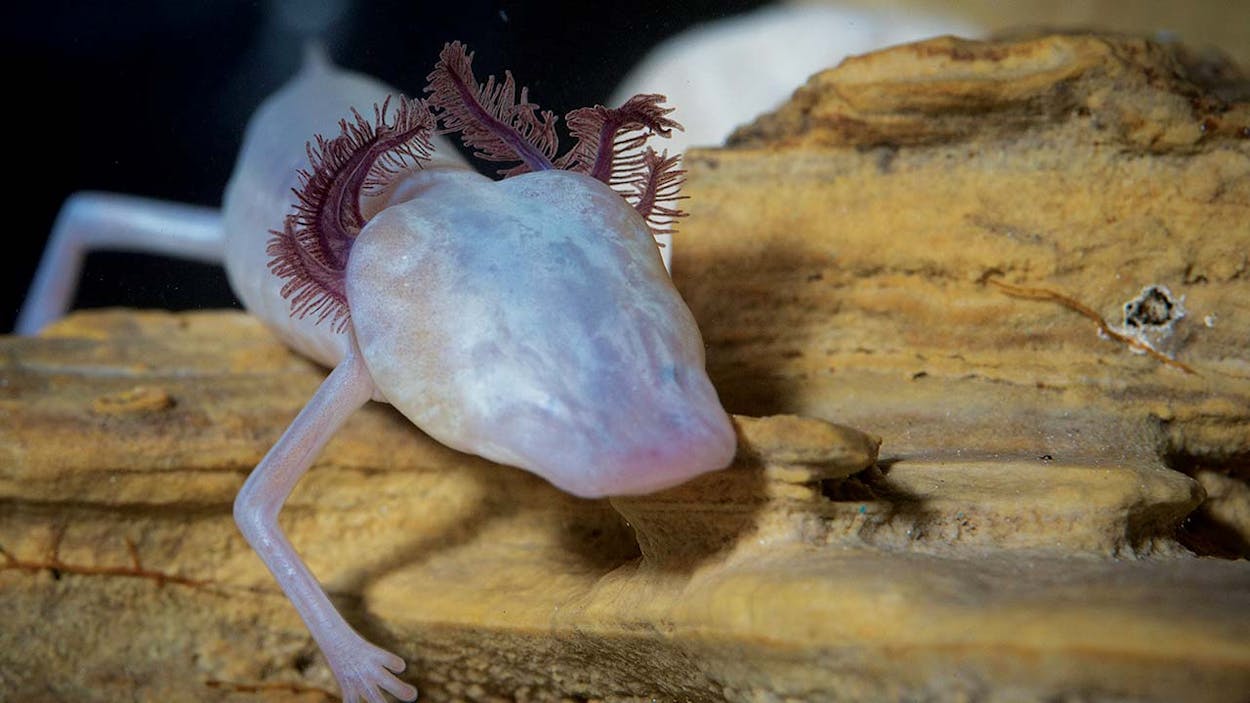Here are the facts as we know them: At 9:35 on the morning of November 25, the staff of the San Marcos Aquatic Resources Center dialed local police to report the disappearance of nearly three hundred Texas blind salamanders. Here’s what else we know: Almost nothing. The facility exhibited no signs of forced entry, and no motive for the crime could be easily divined.
The revelation prompted a flurry of media attention, putting the facility—run by the ordinarily low-drama U.S. Fish and Wildlife Service—at the center of an unsolved crime and casting a spotlight on the crime’s low-profile victims. Like many of the salamanders that live in the Edwards Aquifer region, the Texas blind isn’t a creature that many of us have encountered; it exists only in a small, circumscribed system of underground waterways. Those isolated habitats, though, are fed by runoff from a wide geographic area. A single ill-placed chemical spill could wipe the salamander out, so the Fish and Wildlife Service keeps its own backup colony at the SMARC. The theft occurred just a few weeks before the federal agency was set to create a backup to the backup in Uvalde and leaves the species’ safety net in some jeopardy.
The Texas blind is not without its charms: it’s a cave dweller some five inches in length, eyeless, with a distinctive set of fringy red gills and a pale white body, nearly devoid of pigment. But it has no real use to anybody, so it’s hard, even for scientists who have spent years protecting and studying salamanders, to imagine who would go to the trouble of abducting them. (It seems unlikely that the culprit is, say, a raccoon that found a way to penetrate the SMARC’s defenses and feasted. Three hundred salamanders is a pretty sizable haul for an animal, and, as related by the San Marcos Daily Record, no “partial salamanders or visible blood” could be found in the course of the investigation.)
Though representatives of the SMARC declined to comment, citing the ongoing investigation, other local experts were more forthcoming. “I don’t know why someone would want to steal a bunch of salamanders,” says Nathan Bendik, an environmental scientist with the City of Austin who helps supervise a similar backup colony of Austin blind and Barton Springs salamanders. “Could it be a weird Chinese medicine thing?” he remembers thinking.
Elsewhere in the world, endangered salamander species are indeed used in traditional medicine, or eaten, like the Chinese giant salamander or the axolotl, which lives in Mexico City’s canal system. No such tradition exists for the Texas blind, but Tanya Wyatt, who studies wildlife trafficking at England’s Northumbria University, estimates that a buyer interested in the little critters for food or medicine could be found outside the United States. The theft of hundreds of creatures is not unusual, she adds. “Smuggling large numbers is necessary for the traffickers to make a profit, because so many of the animals die while being smuggled.”
The international trade in supplying reptiles and amphibians to wealthy collectors who simply want to possess such animals is also big business, particularly in Europe. Rare species can go for many thousands of dollars, and smugglers take big risks for a payday. In 1993 police in Madagascar opened fire on the hunting party of renowned German trader Robert Seipp, killing two of his companions and blinding a third.
But the most prized species in the trade are bigger and more obviously striking than the humble Texas blind: New Zealand’s jeweled gecko, Borneo’s earless monitor, Yucatán’s spiny-tailed iguana. And Wyatt notes that the amphibian trade is mostly concerned with rare frogs, not salamanders. Who pines for the Texas blind, and who would take the risk of felony prosecution for breaking into a federal facility to steal hundreds of them? “People are stupid,” Bendik says. Still, he and his staff are now on “high alert.”
In Central Texas, where endangered salamander species have helped shape local politics and changed development plans over many years, the great lengths undertaken to preserve one or another eyeless amphibian can be a running joke. But in other times and places salamanders have carried great mythological power. The Aztecs venerated the axolotl, and it was a widespread belief of many of the ancients that salamanders, like dragons, were born from fire and immune to it. St. Augustine took that power as evidence that the fires of hell, which it was believed did not consume flesh, could be real. In the Talmud, the baby Hezekiah is saved from the fires of the dreaded Moloch when his mother smears him with salamander blood. Perhaps someone sees something similarly magical in the Texas blind.
The case is now in the hands of the San Antonio office of the Fish and Wildlife Service’s law enforcement division, but the rate of recovery in cases of wildlife trafficking are very low. Although SMARC representatives wouldn’t talk about the crime, an email that a Fish and Wildlife spokesperson sent to Texas Monthly offered one intriguing tidbit: contrary to media reports, the salamanders weren’t the only animals abducted from the facility; “a number of species” disappeared that night. The mystery deepens.









